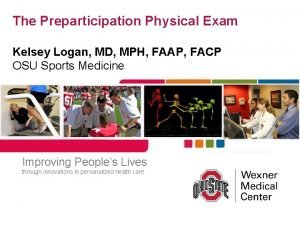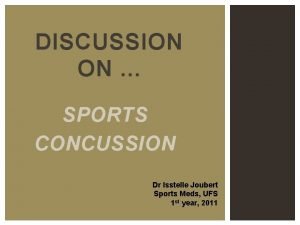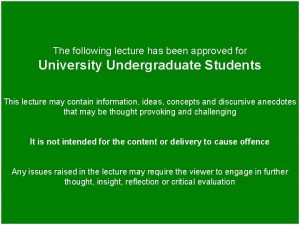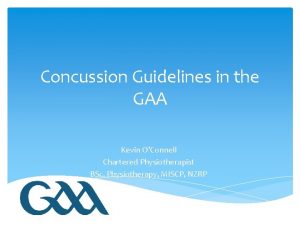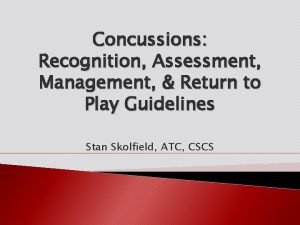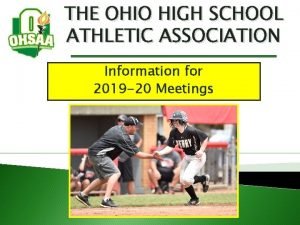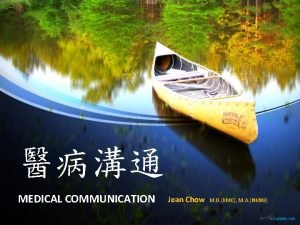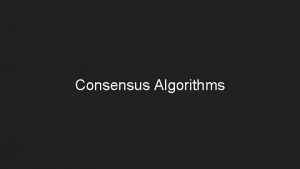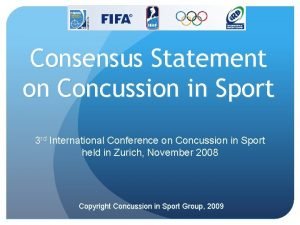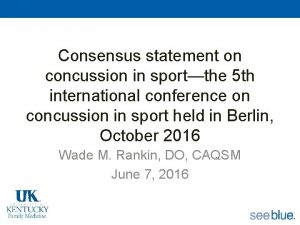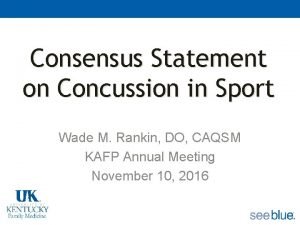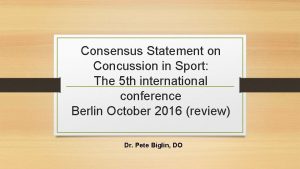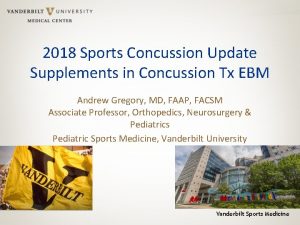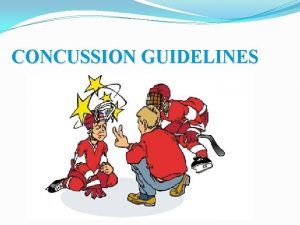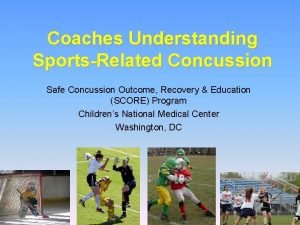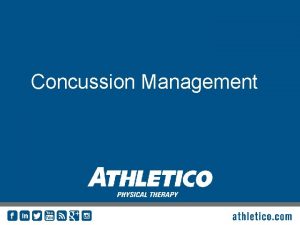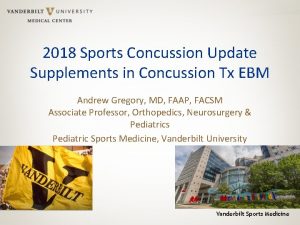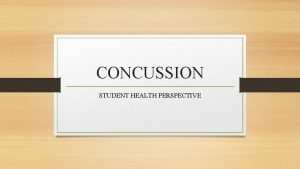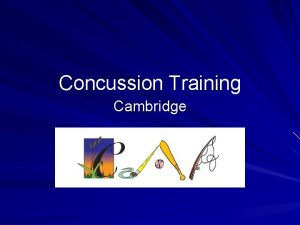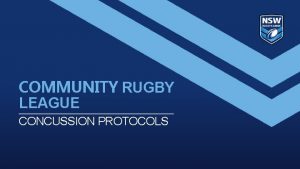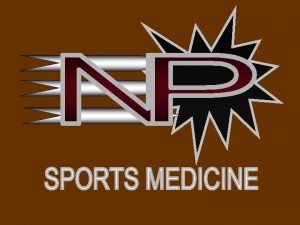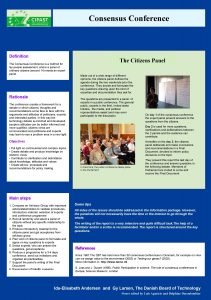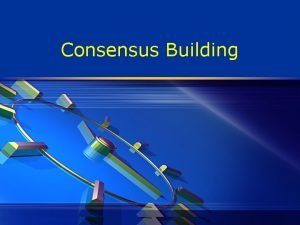The 5 th Consensus Statement on Concussion Statement




















- Slides: 20

The 5 th Consensus Statement on Concussion Statement (Berlin) A 15 Minute Update David W. Lawrence, MD, CCFP(SEM), Dip Sport Med, MPH (Cand)

Overview • • • Definition & Diagnosis Signs and Symptoms Sideline Evaluation Management Neuropsychological Evaluation Persistent Symptoms Residual Effects Prevention SCAT 5

Definition & Diagnosis • Traumatic brain injury • Caused either by a direct or transmitted force to the head • Rapid onset of short-lived impairment of neurological function that resolves spontaneously. • Functional disturbance rather than a structural injury – no abnormality is seen on standard structural neuroimaging studies. • Range of clinical signs and symptoms. • The clinical signs and symptoms cannot be explained by other conditions: – drug, alcohol, medications, other injuries, or other comorbidities

Signs and Symptoms • Symptoms and signs are non-specific to concussion • The suspected diagnosis of SRC can include one or more of the following clinical domains: a. Symptoms: – b. c. d. e. f. somatic, cognitive, and/or emotional symptoms Physical signs Balance impairment Behavioural changes Cognitive impairment Sleep/wake disturbance

Sideline Evaluation ? Concussion Clear signs (LOC, posturing, Sz) Suspected concussion with no signs Sideline screening Immediately removed Diagnostic evaluation Concussion No concussion

Sideline evaluation • • • SCAT 5 Sideline video review Occulomotor screening Reaction time Objective assessment to exclude more serious injury is critical.

Acute Management • Concussion is suspected, the athlete should be removed from the sporting environment • Re-evaluation with consideration of neuroimaging to r/o more severe imaging

Concussion Investigations • No investigations recommended for concussion-specific management. • Biomarkers are important research tools but require further validation prior to clinical use.

Rest • Insufficient evidence to prescribing complete rest. • After a brief period of rest during the acute phase (24– 48 hours) after injury, patients can begin subsymptom threshold progression.

RTA

RTL

Rehabilitation • Additional multidisciplinary interventions – psychological rehabilitation – cervical rehabilitation – vestibular rehabilitation – active rehabilitation – pharmacological treatment

Neuropsychological Assessment • NP assessment has been previously described as the ‘cornerstone’ of concussion management • NP testing has clinical value and contributes significant information • NP assessment should not be the sole basis of management decisions • Post-injury NP testing is not required for all athletes • Should be performed by a trained and accredited neuropsychologist. • Brief computerised cognitive evaluation tools are not substitutes for complete NP assessment. • Baseline or pre-season NP testing not felt to be required as a mandatory aspect of every assessment.

Post-Concussion Syndrome Persistent Symptoms • Failure of normal clinical recovery – symptoms that persist beyond expected time frames (ie, >10– 14 days in adults and >4 weeks in children). • Does not reflect a single pathophysiological entity • Constellation of non-specific post-traumatic symptoms • May be linked to coexisting and/ or confounding factors • Does not necessarily reflect ongoing physiological injury to the brain

Establishing Recovery • “Difficult task”

Special Populations • Elite athletes: – no difference • Child and adolescent: – Children and adolescents should not return to sport until they have successfully returned to school. – Early introduction of symptom-limited physical activity is appropriate.

Chronic Traumatic Encephalopathy Residual Effects and Sequelae • Clinicians need to be mindful of the potential for long-term problems in the management of all athletes. • Literature on long-term consequences of exposure to recurrent head trauma is inconsistent. • There is much more to learn about the potential cause-and-effect relationships of repetitive headimpact exposure and concussions.

CTE • The potential for developing chronic traumatic encephalopathy (CTE) must be a consideration – Distinct tauopathy with an unknown incidence in athletic populations. – Cause-and-effect relationship bw CTE and concussion has not yet been demonstrated – The notion that repeated concussion or subconcussive impacts cause CTE remains unknown.

Prevention • Helmets: – Evidence is limited for an overall effect – There is sufficient evidence in skiing/snowboarding to recommend use to prevent overall head injuries • Mouth guards: – Evidence is limited for an overall effect – Meta-analysis suggests a non-significant trend towards a protective effect in collision sports • Intrinsic risk factors: – No evidence • Extrinsic risk factors (i. e. rule & policy changes) – Strong evidence

SCTA 5 • The SCAT is useful immediately after injury in differentiating concussed from non-concussed athletes • Its utility appears to decrease significantly 3– 5 days after injury. • The symptom checklist, however, does demonstrate clinical utility in tracking recovery. • Baseline testing may be useful, but is not necessary for interpreting post-injury scores.
 2 minute orthopedic exam
2 minute orthopedic exam Concussion betekenis
Concussion betekenis Nausea vomitting
Nausea vomitting Concussion protocol gaa
Concussion protocol gaa Grade 2 concussion
Grade 2 concussion Ohsaa concussion return to play protocol
Ohsaa concussion return to play protocol Grade 2 concussion
Grade 2 concussion Pwcs concussion training 2021
Pwcs concussion training 2021 Brian chow md
Brian chow md Tư thế ngồi viết
Tư thế ngồi viết đặc điểm cơ thể của người tối cổ
đặc điểm cơ thể của người tối cổ Cái miệng bé xinh thế chỉ nói điều hay thôi
Cái miệng bé xinh thế chỉ nói điều hay thôi Hát kết hợp bộ gõ cơ thể
Hát kết hợp bộ gõ cơ thể Mật thư anh em như thể tay chân
Mật thư anh em như thể tay chân Tư thế ngồi viết
Tư thế ngồi viết ưu thế lai là gì
ưu thế lai là gì Voi kéo gỗ như thế nào
Voi kéo gỗ như thế nào Thẻ vin
Thẻ vin Thơ thất ngôn tứ tuyệt đường luật
Thơ thất ngôn tứ tuyệt đường luật Các châu lục và đại dương trên thế giới
Các châu lục và đại dương trên thế giới Từ ngữ thể hiện lòng nhân hậu
Từ ngữ thể hiện lòng nhân hậu
